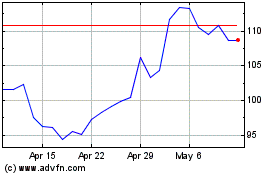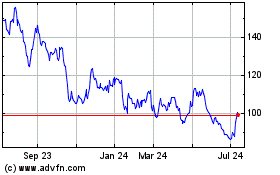By Lara O'Reilly
Facebook Inc. and Alphabet Inc.'s Google tower so far above the
rest of the digital advertising world that no company can claim the
mantle of No. 3. But many are trying.
Snapchat parent Snap Inc. believes it has the young eyeballs
advertisers crave. Amazon.com Inc., ever the disrupter, has the
ability to upend the whole business with its extensive data.
Verizon Communications Inc. is betting on its blend of web content,
location data and ad technology following the purchases of AOL and
Yahoo, while AT&T Inc. thinks buying Time Warner Inc. will give
it an edge.
With the exception of Chinese internet giants Alibaba Group
Holding Ltd., Baidu Inc. and Tencent Holdings Ltd., which dominate
their home market -- where their Western rivals are restricted --
none of the would-be challengers to the Google-Facebook "duopoly"
even cracks a 3% share of global digital advertising.
Google and Facebook together collect nearly half of global
spending. Last year, the U.S. online ad market expanded by nearly
$12 billion and the two firms accounted for over 77% of that
spending growth, according to eMarketer.
Advertisers are hoping for the emergence of a legitimate third
player to provide competition that can give them more leverage and
help keep prices in check. For ad agencies, the matter is
existential: Google and Facebook have the resources to deploy
entire teams to work with marketers directly, cutting out the
middleman.
Wenda Harris Millard, vice chairman at advertising and media
consulting firm MediaLink, said that to compete with Google and
Facebook, other players will need to create premium content that
appeals to advertisers or use new technologies that aren't yet
mainstream.
"Maybe the third player competes on different grounds," Ms.
Millard said.
Many ad executives believe Amazon, which has expanded
successfully beyond its core retail business into areas like
streaming video and artificial intelligence, has the greatest
chance of taking on the "duopoly."
Amazon already allows marketers to place search ads on its
website, as well as display ads on all its platforms. The company
also built a tool that lets companies tap the e-commerce giant's
data on its consumers' shopping habits in order to more efficiently
place ads elsewhere on the web. And Amazon is helping publishers
make more money from the ads on their sites with a so-called
"header bidding" product that gives multiple buyers a chance to bid
on their ads at the same time.
EMarketer predicts Amazon will generate $1.81 billion in ad
revenue world-wide in 2017, a tiny fraction of Google's $74
billion. Amazon declined to comment.
"Amazon is going to be an increasingly important force and one
we have to better understand and link with effectively for our
clients," Martin Sorrell, the chief executive of ad holding giant
WPP PLC said at the company's annual meeting earlier this month. He
said the company was "highly disruptive in many ways."
On Amazon's first-quarter earnings call in April, Chief
Financial Officer Brian Olsavsky said the company was "very happy"
with the growth of its ad business.
Snap is the newest contender for the third-place rosette. In 5
1/2 years, Snapchat has grown to 166 million active users -- a mere
blip compared with Facebook's 1.24 billion daily active users,
though the gap is much narrower in strong ad markets like the U.S.
and Canada.
Snapchat's advantage is that its audience is mostly made up of
the 18- to 34-year-old segment. On average, each Snapchatter spends
more than 30 minutes daily in the app, giving advertisers lots of
opportunities to target them. Snapchat has also brought on board
several TV companies and publishers for the app's "Discover"
section, offering marketers the opportunity to position their ads
next to curated content.
Snap's ad business still has some catching up to do: Its average
revenue per user in North America in its first quarter was $1.81,
while Facebook clocked $16.56 per user in the U.S. and Canada.
Snap declined to comment.
Verizon also is emerging as a "new" player, having just merged
AOL and Yahoo to form an advertising and content unit of the
company called "Oath."
"There are only three companies in the world that touch one
billion consumers digitally -- Facebook, Google, and Oath," said
former AOL boss Tim Armstrong -- now the CEO of Oath -- in an
interview.
Mr. Armstrong believes the company can expand its reach to two
billion people world-wide and ratchet up revenue to between $10
billion and $20 billion by around 2020. The recipe: ad technology
it has spent years investing in, location data and well-known web
brands including HuffPost and Yahoo Sports.
He said rivals to Google and Facebook can zero in on "white
spaces" with no dominant player: promoting brands instead of
specific products, and using newer technologies such as augmented
reality and virtual reality, for example.
Verizon's chief rival, AT&T, has its own lofty ambitions.
AT&T CEO Randall Stephenson said at a conference in May that
the Time Warner acquisition would create an entity that delivers
nearly "one trillion" ad impressions a year. Mr. Stephenson said
his company will be able to make money from Warner Bros. and Turner
shows at a higher rate because it has data on AT&T subscribers'
internet usage that can help marketers more accurately target their
intended audiences.
For the foreseeable future, Madison Avenue will have to get used
to dealing with two dominant players, a dynamic that isn't totally
alien in the ad business.
"From a small-business perspective it's not much different than
when Yellow Pages was the only game in town," said Pivotal Research
analyst Brian Weiser. "For large brands, it's not that different
than the era where there were three [TV] networks."
Write to Lara O'Reilly at lara.o'reilly@wsj.com
(END) Dow Jones Newswires
June 20, 2017 02:48 ET (06:48 GMT)
Copyright (c) 2017 Dow Jones & Company, Inc.
Baidu (NASDAQ:BIDU)
Historical Stock Chart
From Mar 2024 to Apr 2024

Baidu (NASDAQ:BIDU)
Historical Stock Chart
From Apr 2023 to Apr 2024
